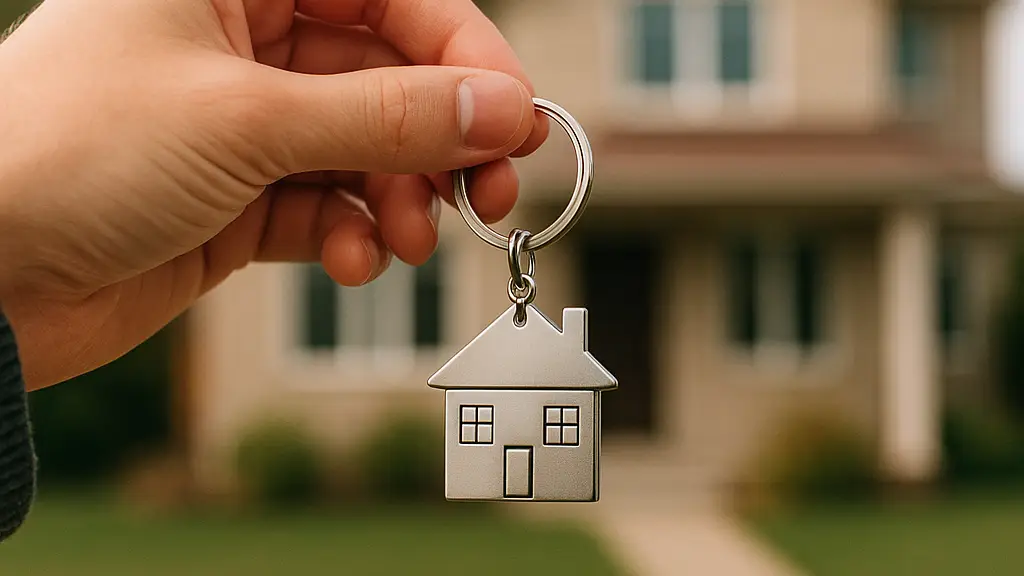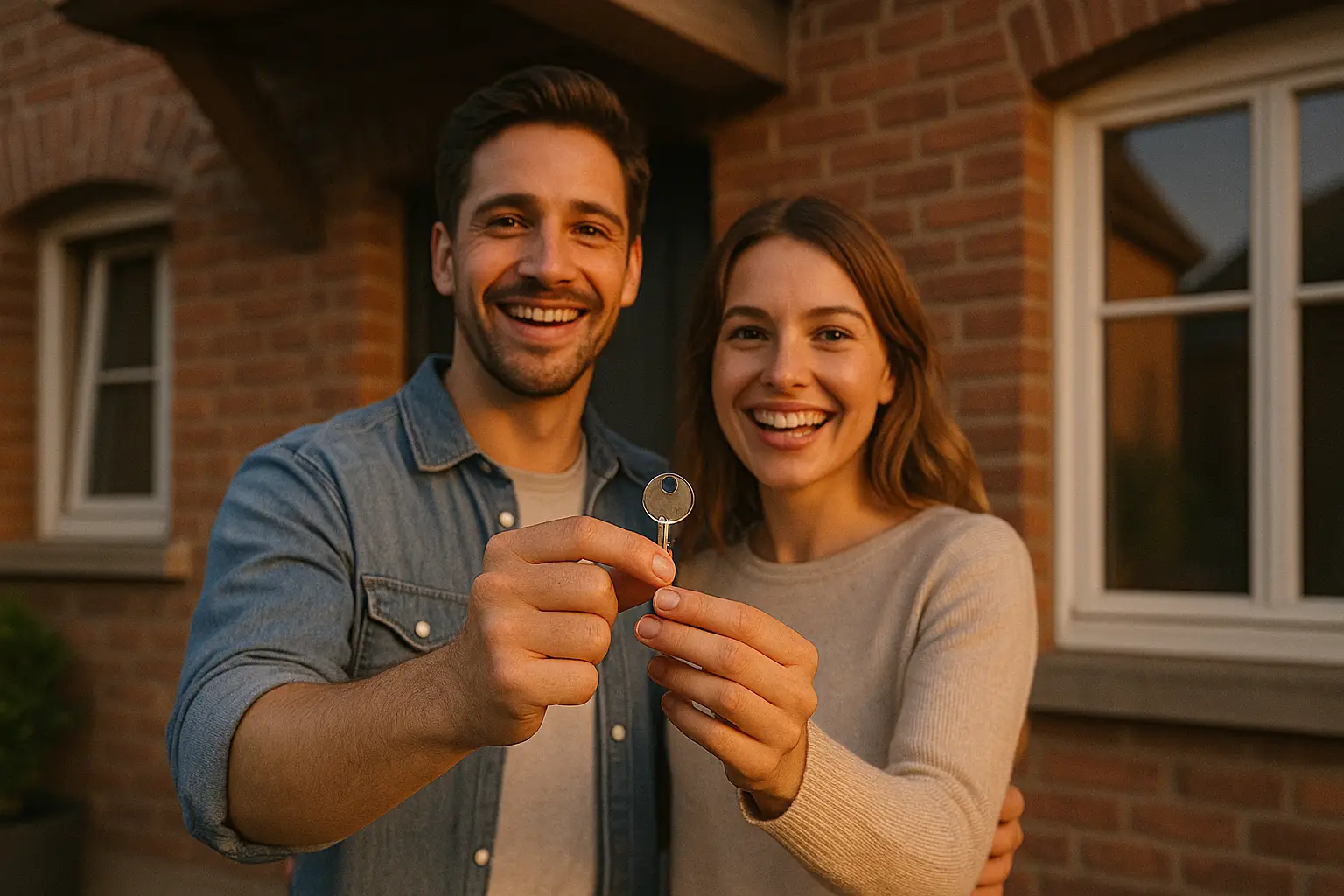Warning, borrowing money also costs money.
Become a Homeowner: The Complete Guide to Buying Your House
Buying a home is an exciting life milestone. Whether it’s your first purchase, your future family nest, or a new residence, we are here to guide you every step of the way. Discover how to turn your dream into reality, from defining your project to receiving the keys.
Simulate your purchase projectLegal Notice
** A loan commits you and must be repaid. Check your repayment capabilities before committing. The rates indicated are for information purposes only and subject to approval of your application.
The Real Estate Adventure: Where to Begin?
Buying a home is much more than a simple transaction; it’s a life project. The first step is to clearly define your desires and needs. With a clear vision, you can search effectively and find the right financing to make your acquisition in Belgium or Luxembourg a reality.
What is your life project?
- My first purchase: The big leap into homeownership, a foundational step.
- A home for my family: Finding the ideal space to watch your children grow.
- A second home: A peaceful haven for your getaways and weekends.
- A construction project: Building the house that reflects you, from the first stone to the roof.
- An investment for the future: Acquiring a property to rent out and build your wealth.
Our online simulator is the first tool to frame your project. It allows you to instantly estimate:
- Your overall purchase budget based on your income.
- The monthly loan payment you could comfortably afford.
- The repayment term that matches your life project.
Buying a home is a major commitment. Good financial preparation and guidance from mortgage experts are the keys to approaching this project with serenity and confidence.
Free • No obligation • Get a clear vision

The Pillars of Your Successful Purchase Project
Becoming a homeowner is a goal that offers many advantages and great personal satisfaction. Here’s why embarking on the home-buying adventure is an excellent decision:
-
Build your “home”: No more throwing money away on rent! Each payment brings you closer to full ownership and allows you to build a lasting asset for you and your family.
-
The freedom to customize: Your house, your rules. You have complete freedom to decorate, renovate, and adapt your living space to your tastes and your family’s evolution, without needing permission.
-
Stability and security: Being a homeowner provides residential and financial stability. With a fixed-rate loan, you control your housing budget over the long term, safe from rent increases.
-
A tangible investment: Real estate remains a safe haven asset. Property tends to appreciate in value over the long term, making it an excellent investment to prepare for your future.
For this project to be a success, financing is the cornerstone. A well-structured mortgage, with the right rate and term, is the tool that will make your dream accessible and financially comfortable.
Your 5-Step Roadmap to Homeownership
The path to becoming a homeowner is marked by clear steps. Here is your guide to see things clearly:
1. Define Your Dream and Budget
Clarify your desires (house, apartment, garden?) and use our simulator to assess your purchasing power. This is the starting point for everything.
2. The Search for the Ideal Property
With a budget in mind, start the viewings! This is the time to find the property that meets your criteria and where you can see yourself living.
3. Assembling Your File
Once the property is found, gather the necessary documents for your loan application. A complete file is the key to a quick response.
4. Sales Agreement & Loan Offer
You sign the preliminary sales agreement (often conditional on obtaining the loan) and receive our formal financing offer.
5. Signing and Handover of Keys!
The big day! You sign the deed of sale and the loan agreement at the notary’s office. The house is yours, congratulations!
Our advisors support you at every stage, ensuring a smooth and serene journey.

Understanding Financing Options for Your Purchase
The mortgage loan is the tool that will finance your home. Choosing the right formula is essential for your peace of mind. Here are the main choices:
-
The security of a fixed rate: Your monthly payments are the same from the first to the last day of the loan. This is the ideal option for perfect budget visibility, with no surprises.
-
The flexibility of a variable rate: The rate can change with the market, both up and down. It often offers a more attractive starting rate and can be beneficial if you anticipate a drop in rates.
-
The compromise of a semi-variable rate: A hybrid solution that combines a fixed-rate period for initial security, followed by a variable-rate period for flexibility.
-
The importance of a down payment: This is the amount you invest yourself. It is generally used to cover the purchase costs (notary, registration fees) and reassures the lender. The larger your down payment, the better your loan conditions will be.
Don’t forget the essential insurances: outstanding balance insurance to protect your loved ones and home insurance to protect your property. Our advisors are here to explain each option in detail and find the perfect solution for your project.
Your Checklist for a Successful Purchase
A forewarned buyer is a forearmed one! Put all the chances on your side by carefully preparing your project.
1. Do the Math
Analyze your income, expenses, and available savings. This will give you a clear picture of the monthly payment you can handle without stress and the down payment you can dedicate to your project.
2. List Your Criteria
Location, number of bedrooms, garden, proximity to schools or transport… The more precise your wish list is, the more effective and targeted your search for the ideal home will be.
3. Prepare Your Documents
Get ahead by gathering your payslips, ID card, bank statements… A well-prepared financing file is the best way to speed up the process once you’ve found the perfect gem.
This preparation will give you confidence during viewings and negotiations, and will greatly facilitate obtaining your loan.

They Took the Plunge: Their Purchase Experience with Us
“Buying our first home seemed like a mountain to climb. CPE Crédit turned it into a clearly marked and reassuring journey. Our advisor helped us define our budget, then secure the loan once we found the one we fell in love with. Exceptional service!”
“We were looking for a bigger house for our growing family. The team was very responsive in analyzing our situation and proposing a financing solution that took into account the sale of our old property. The process was simple and efficient.”
What our clients appreciate most about their purchase project:
- The feeling of being guided at every key stage of the process.
- The clarity of explanations on complex topics like rates or fees.
- The peace of mind of knowing their financing is in good hands.
Your home project is unique. We are here to offer you the tailored support that will lead it to success.
FAQ: I’m Buying a Home
Find answers here to the questions every future homeowner asks. From the first idea to the final signature, we clarify every point of your purchase project.
The home-buying journey unfolds in several key phases:
- Defining the project and budget: Assess your needs (type of property, location) and your financial capacity (down payment, desired monthly payment).
- Searching for the property: The phase of viewings and selection.
- Making an offer: You make a proposal to the seller.
- Assembling the financing file: You submit your mortgage application.
- Signing the preliminary sales agreement: The first formal commitment, often conditional on obtaining your loan.
- Receiving the loan offer: The bank sends you its official offer.
- Signing the final deed of sale: The final meeting at the notary’s office to sign the deed of sale and the loan agreement. You get the keys!
The down payment is crucial. Generally, it is strongly recommended, or even required, that your down payment covers all the costs associated with the purchase, which are not included in the house price. These costs include:
- Registration fees (or VAT for a new property).
- Notary fees for the deed of sale and the loan agreement.
- Administrative fees and processing fees.
In total, these costs often represent between 10% and 15% of the purchase price in Belgium. A down payment that covers not only these costs but also part of the property price is a considerable advantage: it makes it easier to obtain the loan and can give you access to a better interest rate.
This is a personal decision, but here is a guideline:
- The fixed rate is often favored by first-time buyers. Its advantage is absolute security: your monthly payments will never increase, which allows for serene long-term budgeting.
- The variable rate can be attractive if rates are historically high and you anticipate a decrease. It offers a lower starting rate but carries a risk of increase. It’s a choice for those with a tolerance for risk and/or the financial capacity to absorb a potential increase in monthly payments.
For a first purchase, the peace of mind of a fixed rate is often the most reassuring choice. Our advisors can simulate both scenarios to help you decide.
The most common terms for a home loan range from 15 to 25 years. The choice depends on a balance:
- A shorter term (e.g., 15-20 years): Your monthly payments will be higher, but the total cost of your loan will be lower (you will pay less interest overall).
- A longer term (e.g., 25 years): Your monthly payments will be lower, giving you more budget flexibility each month. However, the total cost of the loan will be higher.
The ideal term is one that allows you to comfortably repay your loan while continuing to live, save, and enjoy life. The age at the end of the loan (usually before 75) is also a determining factor.
These are two distinct and crucial notarial steps:
- The preliminary sales agreement (or “compromis de vente”) is the first contract that officially binds the buyer and the seller. It sets the price, the property involved, and the conditions of the sale (including the loan contingency clause). Once signed, you are committed, provided the conditions are met. It is from this point that you finalize your loan application.
- The final deed of sale (or “acte authentique”) is the final document signed at the notary’s office, usually a few months (maximum 4 in Belgium) after the preliminary agreement. It is at this moment that the loan is released, the seller is paid, and the ownership of the property is officially transferred to you. You receive the keys at the end of this signing.
The listed price of the house is not the total cost. You must anticipate the “acquisition costs” (often mistakenly called “notary fees”). They include:
- Registration fees (or VAT if new): The largest part of the costs. The rate varies depending on the region and situation (e.g., 3%, 6%, 12.5% in Belgium).
- Notary fees: Legal remuneration for drafting the deeds (sale and loan).
- Administrative costs: Costs of urban planning searches, land registry inquiries, etc.
- Loan-related fees: Bank processing fees and fees for registering the mortgage.
- Appraisal fees: If the bank requests an expert valuation of the property.
It is prudent to budget for an amount of about 10% to 15% of the property price to cover all these costs. Our advisors can provide you with a precise estimate for your project.